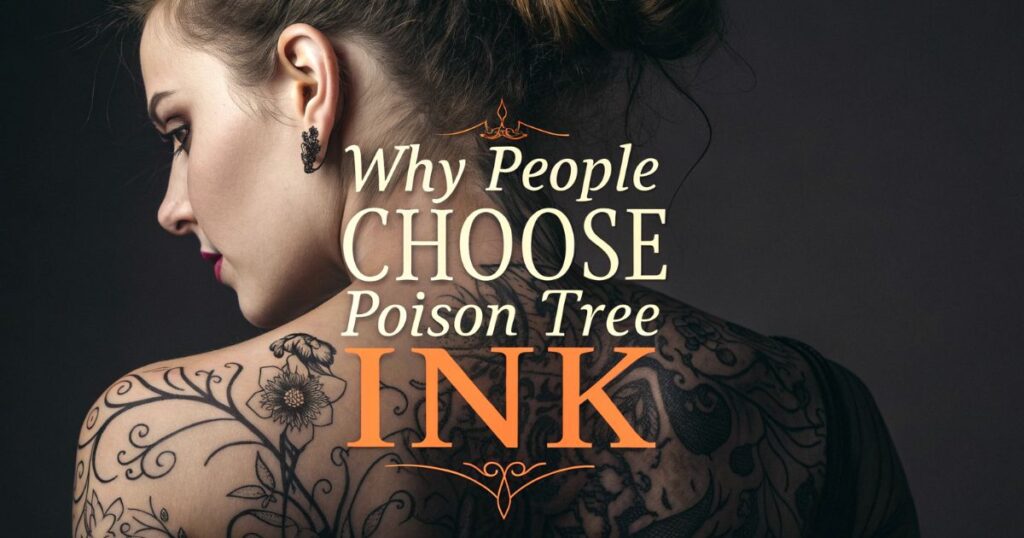Poison tree tattoos represent one of the most psychologically complex designs in modern body art.
These haunting symbols carry deep meanings about suppressed emotions, personal transformation, and the darker aspects of human nature.
Understanding their significance helps you make an informed decision about this powerful tattoo choice.
What Does a Poison Tree Tattoo Actually Mean?
A poison tree tattoo fundamentally represents suppressed anger and unresolved emotional toxicity. The imagery stems from the concept that negative emotions, when left unexpressed, grow into something destructive.
The primary meanings include:
Emotional suppression – hiding anger or resentment until it becomes toxic Personal transformation – acknowledging dark aspects to achieve growth
Warning symbol – reminding yourself or others about emotional boundaries Artistic rebellion – embracing darker aesthetics in tattoo culture
Many people choose this design after experiencing betrayal, trauma, or significant personal conflict. The poison tree becomes a visual reminder of lessons learned through difficult experiences.
However, interpretations vary widely. Some view it as a symbol of inner strength – the ability to survive toxic situations and emerge transformed.
The Literary Foundation – William Blake’s “A Poison Tree” and Its Tattoo Influence
William Blake’s 1794 poem “A Poison Tree” provides the foundational inspiration for these tattoos. The poem explores how suppressed wrath grows into something deadly when not properly addressed.
Blake’s verses describe anger that “grew both day and night” until it bore a “bright apple” that ultimately destroyed an enemy. This literary metaphor resonates powerfully with modern tattoo enthusiasts.
Key Blake influences in poison tree tattoos:
- Apple imagery representing temptation and consequences
- Tree branches symbolizing the growth of negative emotions
- Dark romantic aesthetic matching Blake’s artistic style
- Philosophical depth about human psychology
Many tattoo artists incorporate Blake’s exact imagery – gnarled branches, forbidden fruit, and gothic lettering. The poem’s enduring relevance explains why poison tree tattoos remain popular centuries later.
Literary tattoos often appeal to educated individuals seeking meaningful body art with intellectual depth.
Why People Choose Poison Tree Ink

Poison tree tattoos frequently represent personal experiences with toxic relationships, workplace conflicts, or family dysfunction. The design acknowledges that unexpressed anger can literally poison your emotional well-being.
Common motivations include:
Relationship trauma – marking the end of toxic partnerships Workplace abuse – processing experiences with difficult employers
Family dysfunction – acknowledging generational patterns of toxicity Personal accountability – recognizing your own role in creating negativity
The tattoo serves as both warning and wisdom. It reminds the wearer that suppressed emotions require healthy expression to prevent internal poisoning.
Many clients report feeling emotionally lighter after getting their poison tree tattoo. The process helps externalize internal struggles through permanent art.
Some choose the design to honor their journey from victim to survivor. The poison tree becomes a symbol of resilience rather than destruction.
Spiritual Meaning of the Poison Tree
Spiritually, poison trees connect to ancient concepts about the shadow self and necessary darkness in personal growth. Many spiritual traditions recognize that acknowledging our “poison” leads to healing.
Buddhist interpretation – the poison tree represents attachment and craving that cause suffering Jungian psychology – it symbolizes shadow work and integrating rejected aspects of personality Shamanic traditions – poison plants often serve as medicine when properly understood Alchemical symbolism – transformation requires working with toxic materials
The spiritual poison tree teaches that what appears destructive can become healing medicine. This alchemical principle appeals to people on transformative spiritual journeys.
Many choose this tattoo during major life transitions – divorce, career changes, or recovery from addiction. The poison tree marks their commitment to honest self-examination.
Native American traditions often view certain “poison” plants as powerful healers when used correctly. This paradox influences modern tattoo symbolism.
Popular Poison Tree Tattoo Design Variations You’ll See in American Parlors
American tattoo artists have developed numerous poison tree variations to suit different aesthetic preferences and personal meanings.
Classic Gothic Style:
- Gnarled black branches with thorns
- Skulls nestled among roots
- Victorian-inspired lettering
- Heavy black shading with minimal color
Neo-Traditional Approach:
- Bold outlines with vibrant poison apples
- Decorative elements like roses or daggers
- Rich color palettes emphasizing reds and greens
- Modern artistic techniques with traditional symbolism
Minimalist Designs:
- Simple line work depicting bare branches
- Small-scale pieces perfect for wrists or ankles
- Geometric interpretations of tree structures
- Subtle dot work creating textural interest
Realistic Portraits:
- Photorealistic dead trees with intricate bark detail
- Seasonal variations showing decay and renewal
- Environmental elements like storms or fog
- Integration with landscape backgrounds
Watercolor Effects:
- Abstract poison dripping from branches
- Colorful backgrounds contrasting dark trees
- Artistic bleeding effects mimicking emotional release
- Contemporary techniques popular with younger clients
Dark Romanticism and Gothic Aesthetics
Poison tree tattoos perfectly embody dark romantic aesthetics that have captivated artists for centuries. This movement celebrates beauty found in decay, death, and psychological complexity.
Gothic elements commonly featured:
Architectural details – incorporating church spires or castle silhouettes Creature companions – ravens, bats, or serpents among branches
Weather effects – storms, mist, or moonlight creating atmosphere Vintage typography – old English or blackletter fonts for text elements
The dark romantic appeal attracts people who appreciate sophisticated melancholy over simple happiness. These individuals often connect with authors like Edgar Allan Poe or musicians in the gothic genre.
Color palettes typically emphasize deep purples, blood reds, and stark black contrasts. This creates dramatic visual impact that photographs beautifully for social media.
Gothic poison trees work especially well as larger pieces where intricate details can be properly executed. Sleeve tattoos or back pieces allow for full artistic expression.
Psychological Interpretation – What Your Poison Tree Tattoo Says About You
Psychologically, choosing a poison tree tattoo suggests several personality traits and life experiences that mental health professionals find significant.
High emotional intelligence – recognizing the complexity of human emotions Intellectual depth – appreciating literary and philosophical symbolism
Personal growth orientation – using difficult experiences for development Aesthetic sophistication – preferring complex art over simple designs
People with poison tree tattoos often score higher on openness to experience and tend toward introspective personality types. They’re typically comfortable with ambiguity and psychological complexity.
The choice may indicate past trauma that’s been processed healthily rather than suppressed. Mental health research shows that artistic expression helps integrate difficult experiences.
However, timing matters significantly. Getting this tattoo during active crisis might indicate unhealthy rumination rather than healthy processing.
Licensed therapists sometimes recommend waiting until emotional wounds have partially healed before permanent artistic commemoration.
Placement Ideas That Enhance Your Poison Tree Tattoo’s Symbolic Power
Poison tree placement dramatically affects both visual impact and personal meaning. Strategic location choices can enhance the tattoo’s psychological significance.
Arm placements:
- Forearm – visible reminder of personal boundaries
- Upper arm – easily concealed for professional settings
- Full sleeve – allows for elaborate root systems and environmental details
Torso locations:
- Chest – close to heart symbolizing emotional significance
- Back – large canvas for detailed artistic expression
- Ribcage – intimate placement for personal meaning
Leg options:
- Thigh – popular for larger, detailed designs
- Calf – good proportion for medium-sized trees
- Ankle – minimalist versions work well
Unique placements:
- Shoulder blade – creates interesting angles with body movement
- Behind ear – small, subtle poison apple designs
- Finger – tiny branch or leaf elements
Consider your lifestyle and career requirements when choosing placement. Many professionals opt for easily concealed locations.
Color Symbolism in Poison Tree Tattoos – From Black Ink to Vibrant Reds
Color choices in poison tree tattoos carry specific symbolic meanings that enhance the overall design impact and personal significance.
Black ink symbolism:
- Classic elegance and timeless appeal
- Represents death, mystery, and the unknown
- Shows fine detail work most effectively
- Ages better than colored tattoos
Red color meanings:
- Blood red – anger, passion, or violence
- Crimson apples – temptation and forbidden desires
- Deep burgundy – sophisticated darkness and maturity
- Bright scarlet – warning and danger signals
Green variations:
- Poison green – sickness, envy, or toxicity
- Forest green – natural growth and life force
- Sickly yellow-green – disease and corruption
- Deep emerald – hidden wisdom and transformation
Purple tones:
- Royal purple – nobility and spiritual depth
- Dark violet – mystery and magic
- Lavender accents – healing and peace
Color combination strategies:
- Monochromatic schemes create cohesive elegance
- Contrasting colors emphasize symbolic tension
- Gradient effects suggest transformation processes
- Selective color use draws attention to specific elements
Biblical and Religious Connections
Poison tree tattoos often reference biblical symbolism, particularly the Tree of Knowledge from Genesis. This connection adds layers of spiritual and moral significance.
Biblical parallels include:
- Forbidden fruit representing temptation and consequence
- Knowledge bringing both wisdom and suffering
- Paradise lost through poor choices
- Divine punishment for disobedience
Many Christians interpret poison tree tattoos as reminders about moral decision-making. The imagery warns against choices that appear attractive but carry hidden dangers.
Jewish mystical traditions view the Tree of Knowledge differently – as necessary for human spiritual development. This interpretation supports the tattoo’s transformative symbolism.
Islamic perspectives also reference forbidden trees in paradise, though cultural attitudes toward tattoos vary significantly among Muslim communities.
Gnostic Christianity sees the serpent and tree as symbols of enlightenment rather than temptation. This alternative reading appeals to people with non-traditional spiritual beliefs.
Consider your religious community’s attitudes before choosing biblically-inspired tattoo designs.
Combining Elements – Skulls, Ravens, and Other Symbols with Poison Trees
Poison tree tattoos work exceptionally well with complementary gothic and symbolic elements that enhance the overall meaning and visual impact.
Popular combination elements:
Skulls and bones:
- Represent mortality and life’s fragility
- Add gothic authenticity to the design
- Symbolize transformation through death
- Create striking contrast with organic tree forms
Ravens and crows:
- Messengers between worlds in mythology
- Intelligence and mystical wisdom
- Death omens in various cultures
- Beautiful black silhouettes against tree branches
Serpents and snakes:
- Biblical temptation symbolism
- Transformation through shedding skin
- Hidden knowledge and wisdom
- Elegant curved lines complementing tree shapes
Roses and thorns:
- Beauty emerging from pain
- Love intertwined with suffering
- Classic gothic romantic imagery
- Color contrast opportunities
Clock and hourglass elements:
- Time’s passage and mortality
- Moments of decision and consequence
- Vintage aesthetic appeal
- Philosophical depth about life choices
Moon and celestial bodies:
- Mysterious nighttime atmosphere
- Feminine divine symbolism
- Cyclical renewal and transformation
- Dramatic lighting effects in the design
Celebrity Poison Tree Tattoos and Pop Culture Influence
While specific celebrity poison tree tattoos aren’t widely documented, gothic and literary tattoos have gained significant pop culture momentum through various influential figures.
Pop culture influences:
- Gothic literature revival in mainstream media
- Dark academia aesthetic trends on social platforms
- Alternative music scene embracing literary symbolism
- Horror movie imagery inspiring tattoo choices
Social media impact:
- Instagram hashtags like #poisontree and #gotictattoos showcase designs
- Pinterest boards collect thousands of poison tree inspiration images
- TikTok videos explain symbolic meanings to younger audiences
- YouTube tattoo channels feature gothic design walkthroughs
Literary tattoo trends:
- Book lovers choosing quotes alongside imagery
- English majors commemorating favorite poems
- Teachers and professors displaying their literary passion
- Writers using tattoos as creative inspiration
The dark academia movement particularly embraces poison tree symbolism as part of intellectual gothic aesthetics.
Choosing the Right Artist for Your Poison Tree Design
Selecting an experienced artist is crucial for poison tree tattoos because they require specific skills in gothic artistry and symbolic representation.
Essential artist qualifications:
Technical skills:
- Fine line work – detailed branches and intricate elements
- Shading expertise – creating depth and atmospheric effects
- Botanical knowledge – realistic tree anatomy and structure
- Gothic style experience – understanding dark romantic aesthetics
Portfolio requirements:
- Multiple examples of tree and nature tattoos
- Gothic or dark artistic pieces
- Literary or symbolic work
- Similar complexity to your desired design
Consultation process:
- Symbolic understanding – artist grasps the meaning you want
- Design collaboration – willing to work with your ideas
- Placement advice – recommendations based on anatomy and lifestyle
- Sizing guidance – realistic expectations about detail levels
Professional standards:
- Licensed studio – proper health department certification
- Clean workspace – sterile equipment and safety protocols
- Quality ink – professional grade materials for longevity
- Aftercare knowledge – detailed healing instructions
Research extensively and don’t rush the decision. Poison tree tattoos deserve artistic expertise.
Aftercare and Longevity
Proper poison tree tattoo aftercare ensures your investment remains beautiful for decades. Gothic designs with fine details require particularly careful healing.
Immediate aftercare (Days 1-14):
- Keep bandage on for 2-4 hours initially
- Gentle cleaning with unscented antibacterial soap
- Thin moisturizer application 2-3 times daily
- No soaking – quick showers only
- Avoid sun exposure completely during healing
Long-term maintenance:
- Daily sunscreen application prevents fading
- Quality moisturizer keeps skin and ink healthy
- Touch-up appointments every 5-10 years as needed
- Professional consultation for any concerning changes
Special considerations for gothic tattoos:
- Black ink longevity – typically ages better than colors
- Fine line preservation – requires careful sun protection
- Detail maintenance – may need more frequent touch-ups
- Color vibrancy – reds and greens fade faster than blacks
Signs requiring professional attention:
- Unusual swelling or redness beyond normal healing
- Infection indicators – warmth, pus, or red streaking
- Allergic reactions – persistent itching or raised areas
- Ink problems – unusual fading or color changes
Alternative Symbolic Trees in Tattoo Art – When Poison Trees Aren’t Right for You
If poison tree symbolism doesn’t resonate with your personal story, numerous alternative tree tattoos offer different meanings while maintaining similar aesthetic appeal.
Popular alternatives:
Tree of Life:
- Positive symbolism – growth, renewal, and connection
- Spiritual significance – many religious traditions feature life trees
- Family representation – roots, trunk, and branches symbolizing lineage
- Optimistic outlook – focuses on growth rather than toxicity
Willow Trees:
- Grief processing – traditional mourning symbolism
- Feminine energy – graceful, flowing lines
- Emotional healing – bending without breaking metaphor
- Romantic melancholy – beautiful sadness rather than toxic anger
Oak Trees:
- Strength and stability – endurance through difficulties
- Wisdom and knowledge – ancient symbolism across cultures
- Protection symbolism – shelter and safety for others
- Masculine energy – strong, rooted, reliable
Cherry Blossom Trees:
- Life’s fragility – beautiful but temporary existence
- Japanese aesthetics – elegant cultural symbolism
- Renewal and hope – spring growth after winter death
- Acceptance of change – embracing life’s natural cycles
Celtic Tree Designs:
- Ancestral connections – honoring family heritage
- Mystical symbolism – druitic and magical associations
- Intricate knotwork – complex artistic appeal
- Balance representation – harmony between earth and sky
Consider your personal values and life philosophy when choosing tree symbolism.
Cost Considerations and Time Investment for Detailed Poison Tree Tattoos
Poison tree tattoo costs vary significantly based on size, complexity, artist experience, and geographical location. Understanding pricing helps you budget appropriately.
Factors affecting price:
Size categories:
- Small (2-4 inches) – $150-$400
- Medium (4-8 inches) – $400-$800
- Large (8+ inches) – $800-$2000+
- Full sleeve integration – $2000-$5000+
Complexity elements:
- Simple silhouettes – lower cost, fewer sessions
- Detailed shading – increases time and expense
- Multiple colors – additional hourly charges
- Intricate elements – skulls, ravens, text additions
Artist experience levels:
- Apprentice artists – $100-150/hour
- Experienced professionals – $150-250/hour
- Master artists – $250-400/hour
- Celebrity tattooers – $400+/hour
Geographic pricing variations:
- Major cities – highest rates due to demand
- Suburban areas – moderate pricing
- Rural locations – potentially lower costs
- International travel – factor in additional expenses
Time investment:
- Consultation – 1 hour design discussion
- Simple designs – 2-4 hours single session
- Complex pieces – 6-12 hours across multiple sessions
- Healing time – 2-4 weeks between sessions
Cultural Sensitivity and Appropriation Concerns with Tree Symbolism
Poison tree tattoos generally avoid cultural appropriation issues because they stem from Western literary traditions. However, understanding cultural sensitivity ensures respectful artistic choices.
Safe symbolic territory:
- Western gothic traditions – Blake, Poe, romantic literature
- Christian biblical imagery – widely shared cultural heritage
- Personal interpretation – individual meaning rather than borrowed symbolism
- Contemporary artistic movements – dark academia, gothic revival
Areas requiring research:
- Celtic tree designs – ensure respectful use of cultural symbols
- Native American plant symbolism – avoid sacred or ceremonial imagery
- Eastern religious trees – understand context before incorporating
- Indigenous traditions – respect closed practices and sacred knowledge
Best practices:
- Research thoroughly – understand origins of symbolic elements
- Ask questions – discuss concerns with knowledgeable artists
- Personal connection – choose symbols meaningful to your heritage
- Respectful representation – avoid stereotypes or oversimplification
When in doubt:
- Stick to personal symbolism – your own interpretation
- Western literary traditions – publicly available cultural heritage
- Contemporary artistic movements – current creative expressions
- Professional guidance – consult culturally informed artists
Cultural awareness demonstrates respect for diverse traditions while allowing personal artistic expression.
Personal Stories – Real People Share Why They Chose Poison Tree Tattoos
Understanding why real individuals choose poison tree tattoos provides insight into the design’s emotional resonance and transformative power.
Sarah, 32, Marketing Director: “My poison tree tattoo represents my journey through workplace bullying. The branches growing up my forearm remind me that I survived something toxic and came out stronger. It’s not about dwelling on anger – it’s about acknowledging that experience shaped who I am today.”
Marcus, 28, English Teacher: “Blake’s poem changed my life in college. My poison tree covers my shoulder blade with the full quote integrated into the branches. Students often ask about it, which opens discussions about emotional intelligence and healthy anger expression. It’s become a teaching tool.”
Jennifer, 45, Therapist: “After my divorce, I needed something to mark my transformation. The poison tree on my thigh includes roots breaking through stone – representing breaking free from toxic patterns. My clients often connect with the symbolism during their own healing journeys.”
David, 35, Musician: “My band plays dark folk music, and the poison tree on my forearm fits our aesthetic perfectly. But it’s deeply personal too – it represents generational trauma I’m working to break in my family. The gothic style matches our album artwork.”
Lisa, 29, Graduate Student: “I chose a minimalist poison tree behind my ear after completing my thesis on dark romanticism. It’s subtle enough for professional settings but meaningful to me. The small design represents how powerful literature can be in just a few lines.”
These stories demonstrate how poison tree tattoos serve both aesthetic and therapeutic purposes for diverse individuals.
FAQs
What does poison tree tattoo mean?
A poison tree tattoo primarily symbolizes suppressed anger and emotional toxicity that grows when left unaddressed. Based on William Blake’s poem, it represents how unexpressed negative emotions can become destructive. Modern interpretations include personal transformation, boundary-setting, and acknowledging the shadow self.
What does A Poison Tree symbolize?
Blake’s “A Poison Tree” symbolizes how suppressed wrath grows into something deadly when not properly expressed. The poem’s tree bears poisonous fruit that ultimately destroys relationships and individuals. In tattoo form, it often represents lessons learned from toxic experiences and personal growth through difficult emotions.
What is the spiritual meaning of the poison tree?
Spiritually, the poison tree represents shadow work and necessary darkness in personal development. Many traditions view it as a symbol of transformation – acknowledging our “poison” or negative aspects leads to healing and wisdom. It connects to alchemical principles where toxic materials become medicine when properly understood.
Do poison tree tattoos have to be dark and gothic?
Not necessarily. While gothic aesthetics are popular, poison tree tattoos can be designed in various styles including minimalist, watercolor, or neo-traditional approaches. The key is maintaining the symbolic meaning while adapting the visual style to your personal preferences.
Are poison tree tattoos appropriate for professional environments?
Placement matters significantly for professional appropriateness. Easily concealed locations like the upper arm, back, or thigh allow you to display your tattoo personally while maintaining professional appearances. Consider your career field’s specific policies regarding visible tattoos.
How long do poison tree tattoos take to complete?
Completion time varies based on size and complexity. Simple designs might require 2-4 hours, while elaborate pieces with detailed shading and additional elements can take 8-12 hours across multiple sessions. Larger pieces like sleeves may require several appointments over months.
Conclusion
Poison tree tattoos offer profound symbolism for individuals processing difficult emotions and personal transformation. Their literary foundation, psychological depth, and artistic versatility make them compelling choices for meaningful body art. Whether you choose gothic complexity or minimalist elegance, this powerful symbol can mark your journey from toxicity to growth.
More Posts
Glizzy Meaning – Explained with Text Examples & Polite Replacement Terms
Anjin Meaning: History, Usage, and Associated Concepts
Definition of Mitigate & Its Everyday Meaning: The Complete Guide

Welcome to Brightnis! I am the admin and creator of this platform. I love questioning ideas and exploring different situations. My goal is to encourage critical thinking and help people see things from new perspectives. Join me in discussing thought-provoking topics and finding unique solutions to everyday challenges!





![225+ Spicy Questions To Ask Your Crush [The Ultimate Collection] 225+ Spicy Questions To Ask Your Crush](https://brightnis.com/wp-content/uploads/2025/05/225-Spicy-Questions-To-Ask-Your-Crush-The-Ultimate-Collection-150x150.jpg)
